There are plenty of options when choosing the largest creatures of the ocean.
We’ve chosen to cover some of the most unusual animals – the ones that are the most alien – and pick out the giants among them.
This is a list of the most reliable recorded sizes of various sea invertebrates found so far. These weird and often frightening creatures live among us, and yet represent only a fraction of what’s out there.
Here’s a look at the largest sea invertebrates in the ocean, we know of!
1. Largest Sea Sponge
Caribbean Giant Barrel Sponge (2.5 m / 8.2 ft)
Sponges are remarkably plant-like at first glance. It may even take a biology degree and a fourth or fifth glance to consider that they aren’t, in fact.
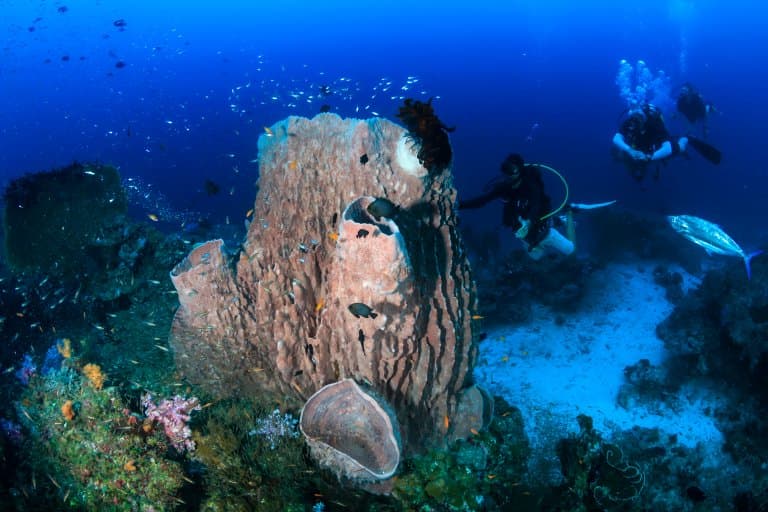
Sponges, the desiccated corpses of which will be familiar to all who shower, are actually a very primitive branch of animal life.
That’s right, you’ve been scrubbing your body with a dead animal.
But that’s okay, because, unlike most animals, sponges don’t have organs. They don’t have a nervous system, blood, digestive tract, or any of that stuff, let alone a brain. In fact, they’re about as basic as an animal can get.
Yet, sponges are incredible. They’re thought to be the last common ancestor of all animal life, and in many cases, they can live for thousands of years. There are over 10,000 species of sponge, some even capable of photosynthesis.
All they do is sit on a rock in the ocean and eat. Quite aptly, they’re good at cleaning the ocean of dirt and bacteria. They come in all shapes and sizes, but the largest, the Caribbean giant barrel sponge, is over 2.5 meters across and may be over 2,000 years old. 1
2. Longest Jellyfish
Lion’s Mane Jellyfish (36.6 m / 120 ft)
Before we get into an argument about whether length or weight is more important than size, we will be covering both here. Starting with the longest, the jellyfish with the farthest reach is the Lion’s Mane jellyfish.
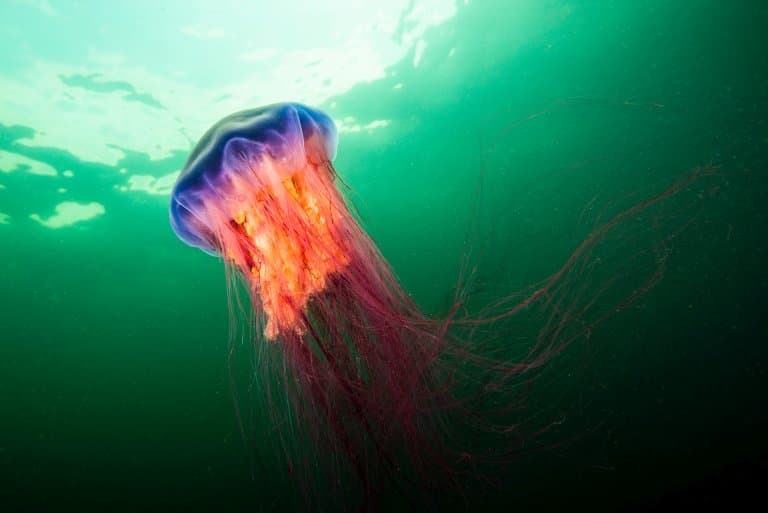
This is a beast! Its bell commonly spans well over two meters, and like most other jellyfish, it dangles long, stinging tentacles into the path of unsuspecting prey animals.
This one can give you a nasty sting, but it’s rarely medically significant. What makes it outstanding is the sheer length of those stingers.
The Lion’s Mane can extend almost 37 meters into the water. It’s thought that this upper limit is a product of the increased drag on the delicate tentacles, meaning that any that grows longer than this will inevitably break off.
Being this large, they often bother divers, and while there’s a common myth that peeing on stings helps, it’s probably better to use hot water to break down the stinging proteins. 2
3. Heaviest Jellyfish
Nomura’s Jellyfish (200 kg)
This one is about the same size as the above jellyfish but occupies a weight class above.
Far from being medically insignificant, its sting is being investigated as a potential treatment for osteoarthritis. Other interesting applications for the heaviest jellyfish in the world include a Japanese ice-cream flavour that uses this species: vanilla and jellyfish.
Recently there have been population explosions of these enormous jellies, likely as a result of overfishing and the general disarray caused by the depletion of our oceans by commercial fisheries.
Climate change also increases the potential range of animals like this, and with a lack of predators, they’re able to cause potentially permanent changes to ecosystems. 3
4. Largest Isopod
Giant Isopod (50 cm / 20 in)
You might know isopods as woodlice or those funny little jumpy things you find in seaweed during low tide, but there are over 10,000 species in this order, and they have a remarkable range.
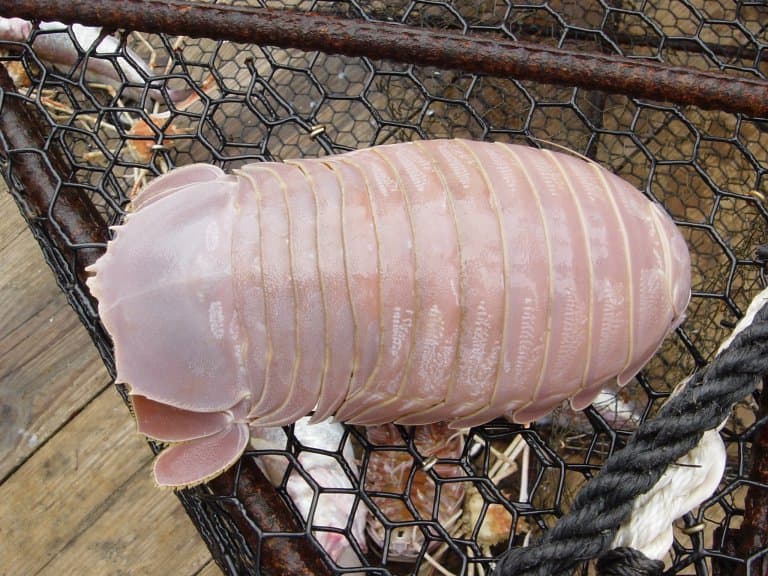
Most live in the sea, and some of the most curious and alien of them all live with all the other curious and alien lifeforms in the deepest parts of the ocean.
Bathynomus giganteus is the largest of them all, reaching half a meter in length, and resembling a sort of half-shrimp, half-woodlouse. They’re enormous to conserve heat in the cold waters of the deep, and probably live a really long time, too.
They’ve been found as far down as 2,140 m (7,020 ft) in the West Atlantic, and are part of the deep-sea cleanup crew, recycling organic fallout from the busy upper levels of the ocean. 4
5. Longest Leg Span
Japanese Spider Crab (3.7 m / 12 ft)
The marine animal with the longest legs is, unsurprisingly, a Martian-like crab creature.
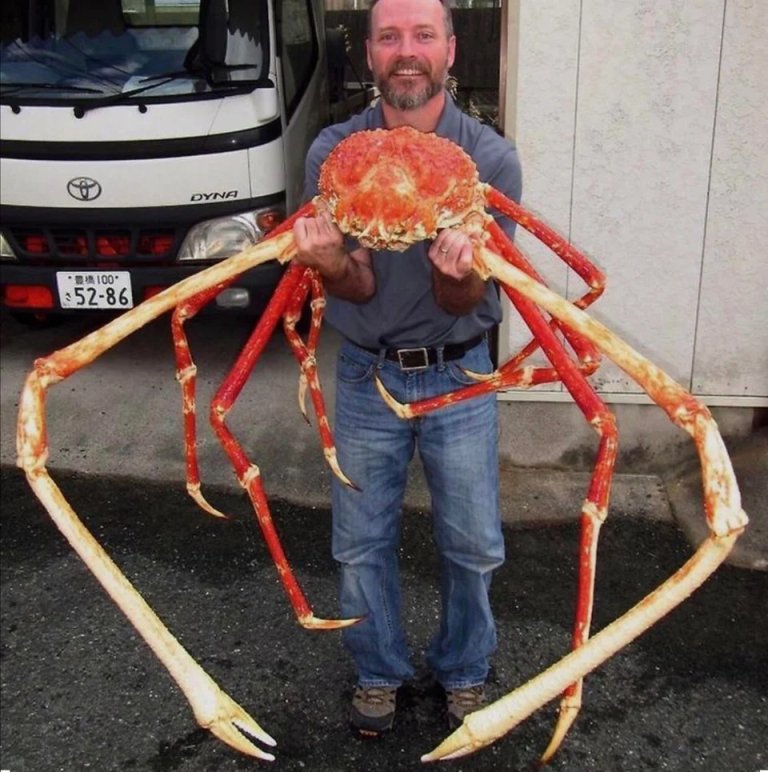
These slow-growing arthropods have had their populations devastated by the fishing industry, and the average size of most crabs caught today is closer to 1m.
They likely take a hundred years to reach the proportions sported by the largest recorded individuals, which means they take a long time to recover from over-fishing.
Spider crabs, like most other crabs, patrol the ocean floor picking up tasty morsels of dead organic matter and recycling it.
When they’re young, they’ll add some of the plant matter they find to their shells, covering themselves in camouflage. By the time they reach giant alien sizes, not much is brave enough to have a go at them, and the spiny carapace and strong claws are enough of a deterrent. 5
6. Longest Annelid Worm
Giant Tube Worm (3 m / 10 ft)
It’s hardly surprising that the largest worm in the sea is a polychaete. These are one of the most unusual animals in the world, let alone among the annelid phylum: one that contains familiar faces like the earthworm and the leech.

The giant tube worm lives at the bottom of the open ocean, particularly common around thermal vents, and begins its life as a free-swimming larva.
Upon entering its next stage, it settles for life near a vent and starts accumulating a strain of bacteria with which it forms a symbiotic relationship. From here, the digestive tract becomes redundant and seemingly disappears.
The bacteria feed off the sulfur-containing compounds belched out of the hydrothermal vents, in turn producing the energy needed to sustain the worm.
These worms have been discovered reaching three meters long, but it’s likely they can grow even larger, given the right conditions.
Nobody really knows how long they can live or when they stop growing, but if the vent ever dies, these worms will lose their nutrient supply. Being fixed to the spot, they’re unable to locate a new home and will die there. 6
7. Largest Bivalve
Giant Clam (137 cm / 54 in)
If you’ve ever had mussels a la crème or reluctantly chugged down an oyster, you’ll be familiar with a bivalve mollusc. These are usually two-shelled, meaty tongue-like animals that typically affix themselves to a rock and filter nutrients from the water.
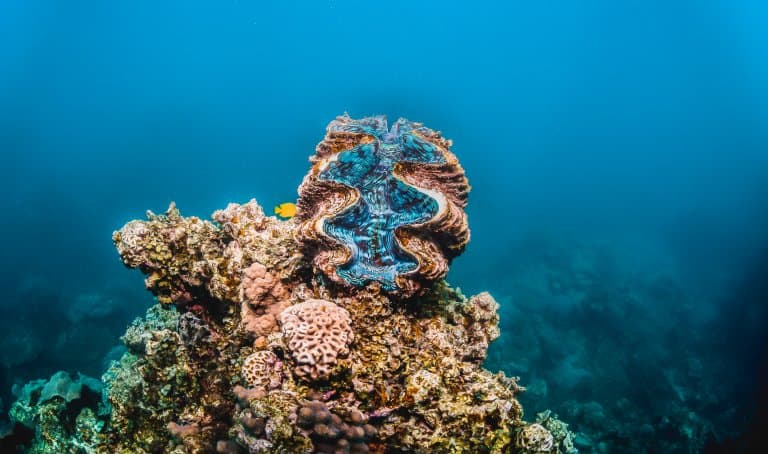
Clams are a good example, and the giant clam is a good example of a good example.
If you’re lucky, you might get around 10g of meat from a very large mussel. for comparison, a single giant clam sports around 33 thousand times the mass.
Giant clams are absolute giants of the clam world and are known in popular movie lore for grabbing a hold of the leg of an unfortunate diver. These are dubious claims, but there are legends of local pearl divers being drowned when the clams snapped shut on their hands.
None of these clam claims has been substantiated so far, and it seems like the really big ones can’t even close their shells all the way, but the legend persists. 7
8. Largest Octopus
Giant Pacific Octopus (9.8 m / 32 ft)
One of the largest cephalopods in the ocean is also one of the smartest. Despite being related to a slug (and a giant clam), the Giant Pacific Octopus is a remarkably intelligent creature, and commonly underrated when it comes to marine monsters.
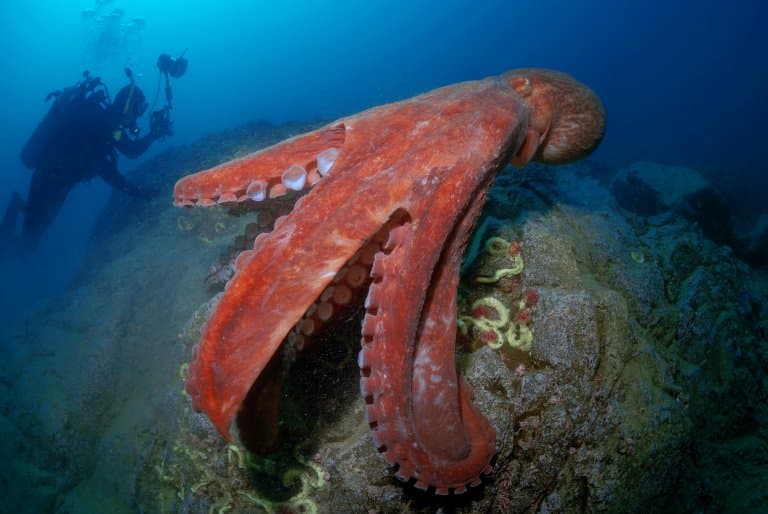
These are the largest of the octopuses and can fan out to almost ten meters across. This happens to be a great intimidation tactic, but also functions to overwhelm prey items and push them toward its powerful beak.
Despite being enormous, it’s a very squishy creature, having no shell or bones, and therefore can squeeze through any hole smaller than its beak.
They don’t usually grow quite as big as the record-holder, but average sizes of six meters and weights of well over 50kg are common.
Their remarkable intelligence is offset by their tragically short lifespan. While long-lived for an octopus, the GPO will not usually make it past 5 years of life, and will always die after reproducing.
They’re able to recognise human faces and are playful and curious animals. They’re also notorious escape artists, well known by people who have kept them in aquariums. 8
9. Heaviest Cephalopod
Colossal Squid (4.2 m / 13.8 ft)
It’s not entirely fair to claim that the octopus is the most intelligent invertebrate when we know so little about their far bigger cousins.
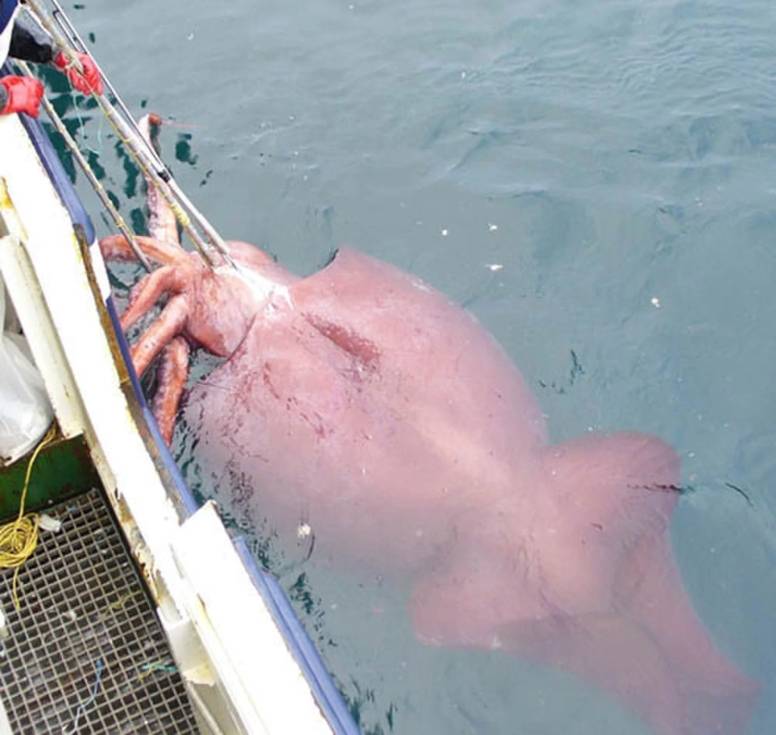
It is sensible when looking at how much smarter a small octopus is than a small squid, that this difference in intelligence will be found between octopus and squid at all scales.
But when it comes to squid, there simply is no octopus that comes even close to the same scale. The most massive invertebrate on earth also has a complex brain and one that’s much larger than the giant octopus.
The difference is, we hardly ever see it.
Colossal squid live in deep waters and are only known from a handful of samples. This means that the largest one confirmed is truly unlikely to be the largest one down there.
But this lack of information also means we have very little idea of how they behave, how they think, or what they’re plotting.
They have the largest eyes of any animal, ever. That alone should send shivers down your spine; that you may be floating about on the surface while an ancient behemoth watches you from the impossible depths.
Like many alien mysteries, they occupy the Southernmost parts of the ocean, possibly up as far down as 4,000 meters. However, they’re unlikely to rush up to the surface to meet you for a couple of reasons:
Firstly, they’d explode from decompression.
Secondly, they have particularly slow metabolisms. Conserving energy in a barren wasteland like the bottom of the ocean is a high priority, and the colossal squid is thought to need an average of about 30g of food per day to maintain its enormous mass.
It’s likely more of a sit-and-wait ambush predator. 9
10. Longest Cephalopod
Giant Squid (12 m / 39 ft)
While the colossal squid is stocky and heavy, the giant squid is a much longer animal. Its body is usually around 2 meters long but may rarely reach over 5 meters. The rest is all tentacle.
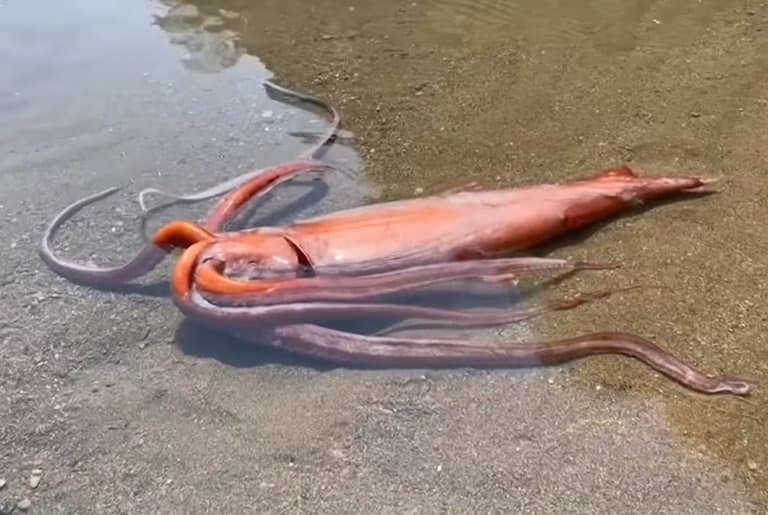
Giant squid are similarly under-studied, for the same reason as the colossal squid. They live in the depths and keep mostly to themselves.
Some of what we know about their size comes from the scars they leave on the ocean’s largest predator: the sperm whale.
Their enormous tentacles are lined with suction cups, which are in turn lined with a ring of sharp teeth-like chitin. These razor slappers leave huge suction-cup marks on the front end of sperm whales and are often found, along with the squid’s huge beaks, inside the whale’s bellies.
Again, these giant molluscs keep their secrets well, and we still don’t know a lot about them. However, since the first live specimen caught on camera was as recent as 2006, chances are they are capable of growing to even more frightening proportions. 10
Final Thoughts
We have yet to explore almost 95% of our oceans, and still, we have been able to cause tremendous harm to them. The migratory nature of many of the animals in the seas means we’ve been able to interrupt global patterns and devastate animal populations vital to the health of ocean ecosystems.
Yet, there’s so much out there! Real alien intelligence, secrets to our evolutionary history, and an untold number of eyes peering at us from the deep.
By protecting our oceans, and moving away from commercial fishing, we ensure that many more of these secrets can one day be unearthed.
Fact Sources & References
- McMurray, S.E., Blum, J.E. & Pawlik, J.R (2008), “Redwood of the reef: growth and age of the giant barrel sponge Xestospongia muta in the Florida Keys“, Mar Biol.
- “Lion’s Mane Jellyfish“, Oceana.
- Masato Kawahara et al. (2003), “Unusual population explosion of the giant jellyfish Nemopilema nomurai (Scyphozoa: Rhizostomeae) in East Asian waters“, MEPS Vol. 307.
- Emily Osterloff (2022), “Giant isopods: curious crustaceans on the ocean floor“, NHM.
- Riebel, W. (2011), “Macrocheira kaempferi“, Animal Diversity Web.
- Privett, B. (2001), “Riftia pachyptila“, Animal Diversity Web.
- “Giant Clam“, National Geographic.
- Dave Cowles (2005), “Enteroctopus dofleini“, Walla Walla University.
- “Colossal Squid“, Oceana.
- Allison Runck (2021), “Giant Squid“, Australian Museum.
